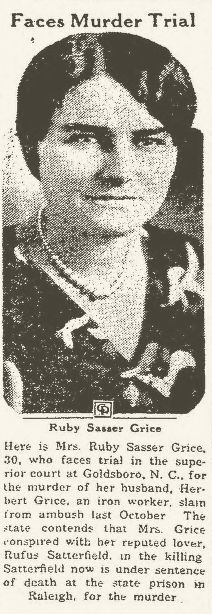Ambush and Betrayal, Satterfield & Grice, 1933
Home | Short Feature Story | Ambush and Betrayal, Satterfield & Grice, 1933
Sunday, October 22, 1933, 8:30 p.m.
Goldsboro, North Carolina
Herbert Grice was in the middle of untying his shoes when he was stopped by the frantic barking of his dogs. They often barked at everything and anything they didn’t approve of, and Grice quickly dismissed their clamor as insignificant. But before he could get his shoes off, their yapping turned into a threatening growl and Grice knew their warning was to be taken serious. As he had done many times before in such instances, the machine shop foreman turned on the outside light, walked out onto his front porch, and called out to the darkness.
The reply to his inquiry was a shotgun blast that sent lead buckshot tearing through him, ripping holes into the screen door, and biting into the walls of the living room. A cloud of plaster dust and wood splinters showered down on his wife, Ruby. The shot missed hitting her and his three children who were in their beds in a nearby room. With a puzzled look on his face, Herbert sank down to the porch floor and died seconds later.
Ten feet in front of the house, Wayne County Sheriff Paul Garrison and other lawmen, found a flattened spot where the killer had sat or knelt as he waited to ambush Grice when he walked outside. Scattered on the ground in that same spot, lawmen found several wooden matchsticks that had been chewed down by the killer—still moist from his saliva.
Using the headlights from their cars to illuminate the area, lawmen discovered the path the killer had used to approach the house.
“The trail led to a ditch, turned right, then crossed through a pine thicket and merged with a dirt road called Linwood Avenue,” crime writer Sam Cohen would later report. At the end of the trail, Garrison’s deputies could make out tire tracks in the soft grass. The killer had parked his car in that spot, and then made his way to the Grice house where he probably counted on the dogs to bark and draw out his victim.
As deputies explored the tracks further, they noticed that the killer walked pigeon-toed, with the toes pointed inward. In one footprint made into the damp soil, they could make out the word “Cushion” on a heel mark.
Among the many friends and neighbors who were brought in for questioning that night and the following day was Herbert Grice’s close friend and Sunday school teacher, Rufus Satterfield. While Satterfield waited patiently at the sheriff’s department to be questioned, he began to chew on wooden match sticks which he disposed in a nearby ash tray. After he was grilled for one hour and recounted his movements that day, he was released as Sheriff Garrison and his men investigated his alibi.
During a two-week investigation, authorities were able to tear down Satterfield’s alibi, link him to a borrowed shotgun, and had an eye witness who saw a man, matching Satterfield’s description, exit a car parked in the same spot the night of the murder. That man, the female witness reported, carried a shotgun and walked along the same path found in the tall grass and soil that investigators discovered.
During his trial held in late February 1934, Satterfield claimed he was innocent and directed all the blame toward Herbert’s wife, Ruby, and her younger brother, Donald Sasser, 21. Satterfield claimed Ruby was his lover, and she and her brother wanted Herbert killed so she could collect on his $5,000 insurance. The prosecutor introduced witnesses who gave testimony that loosely supported Satterfield’s claims. Despite his denials that he was ever involved, Satterfield was found guilty on March 1 and sentenced to death.
Just prior to his trial, Ruby and her brother, Donald, were arrested for complicity to murder. Their trial was held in December and Ruby’s alleged lover, Rufus, was the star witness. Satterfield admitted to the packed courtroom of 1,200 people that he shot Herbert Grice to death but that Donald Sasser was the one who drove him that night. He also toward authorities that Ruby told him “to get Don and go and kill Herbert Grice.” He further alleged that he killed Herbert because he had beaten Ruby on several occasions.
On December 12, 1934, Ruby and Donald were found not guilty. The following day, Rufus Satterfield was strapped into the electric chair and executed. Authorities were never able to conclusively determine who else was in the car that night.
—###—
True Crime Book: Famous Crimes the World Forgot Vol II, 384 pages, Kindle just $3.99, More Amazing True Crime Stories You Never Knew About! = GOLD MEDAL WINNER, True Crime Category, 2018 Independent Publisher Awards.
---
Check Out These Popular Stories on Historical Crime Detective
Posted: Jason Lucky Morrow - Writer/Founder/Editor, July 2nd, 2015 under Short Feature Story.
Tags: 1930s, Love and Jealousy, Love Triangle, Murder, North Carolina, Women









